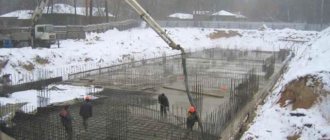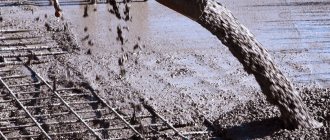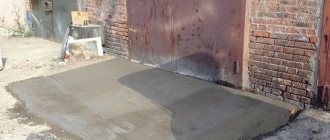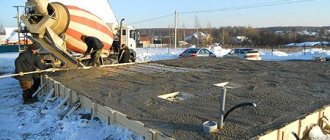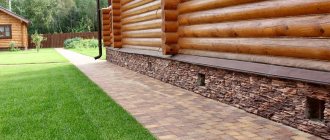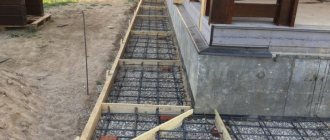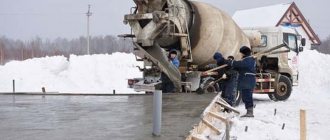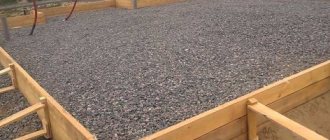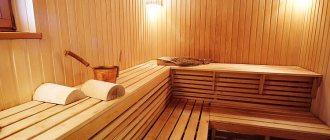Concrete slows down at low temperatures slightly above zero, and negative values destroy the structure of the artificial stone. Pouring concrete in winter means that the water does not have time to react with the cement, freezes and increases its volume. The stresses arising inside destroy the concrete, which has not gained strength. With the arrival of heat, the water defrosts and setting continues. But in the body of the material there are destroyed structures that reduce the load-bearing capacity.
Features of pouring concrete at sub-zero temperatures
At subzero temperatures, it is necessary to accelerate the hardening time and strength gain of concrete
. An optimal environment for hardening concrete is needed if the air has not warmed up more than +5 ° C, or the values are reduced to negative values. Humidity and temperature conditions are created to reduce the hardening time and increase strength in the early stages.
Acceleration methods:
- heating due to the internal heat of the concrete mass;
- supply of heat to the structure from the outside.
The first method is used for fast-hardening varieties, high-strength mixtures, and finely ground varieties of cement. This group contains binders with low fluid consumption. Concreting at subzero temperatures is carried out with the addition of plasticizers to reduce the volume of water required, and chemical antifreeze additives speed up setting.
The temperature inside the product depends on the amount of energy that is produced during the exothermic process of joining water molecules. Such energy is sometimes insufficient to obtain breaking-level strength, and in frost conditions this degree cannot be achieved without additional measures.
Temperature conditions for curing:
- massive structures - not less than +5°C;
- thin-walled structures - not less than +20°C.
Sometimes a sufficient amount of energy can be supplied externally to the product when the readings are negative. The internal heat reserve in concrete is increased by heating the aggregates and liquid. To do this, a certain technology for preparing the solution on the construction site is followed, which requires additional labor and energy costs.
Methods of concreting in winter conditions
The speed of the hardening process depends on the temperature of the solution. When it increases, water activity increases significantly, and the rate of strength gain increases. Therefore, when carrying out concrete work in winter or at temperatures below +5oC, it is important to create and maintain the required level of heating. The optimal aging temperature for the solution is from +20oC to +30oC. There are several ways to do this:
- make the solution heated;
- insulate the formwork;
- use additives and additives that accelerate hardening and/or lower the freezing point of water;
- heat the already poured concrete mass.
All these methods work well. They are used singly or in combination.
Filling in winter is carried out with a heated solution
First of all, it is necessary to choose the right cement for winter concreting the foundation. It is known that during the hardening of concrete, reactions occur during which heat is released. This is a great feature for winter. At the same time, quick-hardening Portland cements and high-grade compositions emit more heat. Therefore, for mixing at low or sub-zero temperatures, it makes sense to buy them.
Only this will allow you to pour a strip or slab foundation at above-zero temperatures during the day and slight frosts at night. But at the same time, you will need to make the batch warm (read below), and after pouring the foundation, you will need to insulate the formwork: cover it with mats, straw, etc. If you have already purchased a heat insulator, you can use it, you just need to monitor its condition and cover it with film or other moisture-proofing materials.
Temperature increase during kneading
During winter pouring of the foundation, the temperature of the solution is brought to 35-40oC. To do this, heat the water and the backfill. Under no circumstances should you heat cement: it will “cook” and become practically useless.
For mixing in winter, use hot water and heated backfill. Cement cannot be heated.
It’s good if it is possible to use an electrically heated concrete mixer: it is plugged in and the drum heats up. In another case, it is advisable to preheat it by swirling heated water.
When kneading, the water is heated to 90 oC. Crushed stone and sand must be heated to 60 oC. This is done by blowing hot air and heating in special ovens. Stoves are a fantasy for a private builder, but you can arrange hot air blowing. For example, stretch several air ducts from a stove or fire into a pile of rubble or sand.
Please note once again: do not heat the cement. It can be brought into a warm room so that it reaches room temperature, but it cannot be heated.
When mixing the solution in winter, the order of laying the components changes: water is poured in, crushed stone and sand are poured into it. After several turns, cement is added.
In addition to this, it is also necessary to increase the kneading time. It should be 20-50% longer: due to better mixing, reactions are activated and the temperature during hardening increases.
Insulation and heating of the solution
To extend the cooling time of concrete, it is necessary to retain heat as much as possible. Therefore, using all possible means and available materials, the walls of the formwork are insulated. You can use tarpaulin, mats, some old warm clothes, fill the gap between the walls of the formwork and the soil, or straw. Anything, as long as the heat doesn’t leak into the air.
One of the tasks is to keep the solution warm
In this case, formwork made of polystyrene foam can be useful - it has poor thermal conductivity, which in these conditions is a definite plus. Typically, such formwork is permanent, and after the concrete has matured, you get a moisture- and heat-insulated foundation. Read more about the types of formwork here.
During construction on an industrial scale, electrical heating is also used using various types of electrodes. They can be located on the surface, fixed to the formwork, or inserted into the concrete solution. The method is effective, but is rarely implemented in private construction. This is a very expensive pleasure: the electricity consumption for heating a cubic meter of concrete is 60-80 kW/hour. In this case, it is necessary to strictly control the temperature: measure it every two hours (or more often) and turn it off when it reaches +30 oC. Then after a while turn it on again. Monitoring must be around the clock.
When pouring a foundation with your own hands in winter, it is realistic to use only heating cables. They are attached from the inside to the formwork, and after its removal they are dismantled. There is a second option - to “drown” the wire in concrete. Both methods work well, but only if the walls are insulated from the cold.
Heating mats are laid on the concrete surface and connected to the network
There are also special heating mats for heating concrete on sale. They are laid out on the surface and plugged into the network. Its cost is 2.5 thousand rubles/m2.
To maintain the temperature, greenhouses are placed above the object. These are structures that are very reminiscent of greenhouses. And their task is similar: to keep warm. A frame is erected and covered with film or other similar materials. They put a stove, a heat gun, etc. inside, and use them to maintain a positive temperature. But at the same time, it is also necessary not to forget about moisturizing so that the moisture from the solution does not evaporate.
What to consider when laying concrete in winter
During the preparation of the mixture, the concrete components are protected from snow drifts, icing and freezing. Binding components are stored in closed containers or bags made of moisture-resistant material. In factories, components, aggregates and water are heated for distribution into vehicle mixers. The solution is prepared in a heated room, so the output is a mass of the required temperature.
Sand and crushed stone are heated by registers in the form of heat exchangers, through the body of which steam or water heated to +90°C passes. The liquid receives temperature in water heaters, from there it is supplied to supply containers. The tanks are placed near the place of preparation and equipped with a device for dosed drainage.
The temperature of the mass may increase if the mixture is prepared in electric mixers, which are heated with steam inside. The mixture is transported in heated vehicle mixers; insulated containers are used.
Concrete is poured at sub-zero temperatures into dump trucks, where the temperature of the body increases due to exhaust gases. The car body is covered with heat-insulated shields, wooden caps or tarpaulins. The mixture is delivered to the place without additional overloads along the way, so as not to reduce the amount of internal energy.
Hoses and concrete pipes are heated before being fed into the formwork, and at the end of the work they are cleaned with scrapers. Washing with water is not allowed to prevent ice from appearing inside the pipe.
Possible consequences
In special frosty conditions, you must remember to follow all the rules for winter filling, otherwise irreversible consequences may occur, after which there can be no talk of any further operation of your facility. Therefore, you must strictly take into account all the standards and calculation data of this matter.
If you pour liquid into concrete during frost and do not do it correctly or with some, even minor, violations, then the thermal processes of hydration in the formwork, which proceed and are completed after about three to five days, may stop completely.
This leads to sad consequences; as a rule, the surface layer of your fill will be loose and crumbly. In this case, the work needs to be completely redone.
Using additives when pouring concrete
The concrete mixture stops setting after the liquid freezes at negative degrees. The conversion of water into ice is slowed down by the inclusion of salts in its composition. Hardening continues at temperatures of 0°C and below if chemical elements are added.
Antifreeze components:
- sodium nitrite;
- sodium chloride + calcium chloride;
- sodium nitrite + calcium chloride;
- urea + calcium nitrate;
- calcium nitrate-nitrite + urea;
- calcium chloride + urea;
- potash.
Additives are selected depending on the design, the amount of reinforcement, the presence of eddy currents, and the surrounding weather. Antifreeze components cannot be added when pouring structures with stressed reinforcement and thermally strengthened metal. Modifiers are not used when concreting structures where there will subsequently be electrification and eddy induction currents will appear.
Antifreeze additives slow down the achievement of strength compared to the setting time in a normal environment and without additives. Potash causes the concrete to strengthen by only 75% in 28 days at -50°C, whereas under normal circumstances the mixture would gain 100% strength.
The effect of additional components on the mechanical and technological properties of the solution, for example, plasticity, workability, is taken into account. Concrete with urea cannot be heated above +40°C, as the additive is destroyed. Chloride salts create a whitish coating on the surface, which worsens the appearance of the structure. The concrete mixture should not contain undissolved salt particles.
Expert advice
In order for all work performed with concrete at low temperatures to give the desired result, you need to adhere to some recommendations that have been tested over the years. This is especially true in cases where a multi-story building is being built. Basic tips:
- The formwork must be prepared in the best possible way. All accumulated snow and ice must be removed from it, and the reinforcement frame and bottom must also be heated to a positive level. In this case, you can use special portable braziers or heat guns, the operation of which is provided by liquefied gas.
- In winter, it is much easier to make a strip foundation, since all work can be divided into several main stages. In addition, in local areas it is much easier to create optimal conditions for the solution to harden.
- If the customer wants builders to create a slab foundation, it will be almost impossible to do this. This is due to the fact that for concrete to harden normally, it is necessary to maintain a certain temperature, despite severe frosts.
- Craftsmen must adhere to a continuous installation method. The peculiarity of this procedure is that even if the foundation is poured in layers, then each subsequent ball must be laid before the previous one hardens.
- As practice shows, the best results during winter concreting can be achieved if you use several proven technologies at once.
Electro-cured concrete technology
To pour concrete in winter, high power is used - over 1 thousand kW to heat 4 - 5 m³ of concrete. In the form of heating electrodes, fittings, metal plates, strips, strings are used; heating is carried out by the peripheral and through methods.
The electrodes supply an electric current, heat is released, which is used to increase the temperature of the shell and concrete mass and compensates for energy losses to the surrounding room. Heating of concrete is determined by the volume of energy produced; the mode is selected depending on heat loss in the cold.
Warming formwork transfers heat from its area by heat transfer; the following elements are used:
- mica plates;
- cables;
- heating elements;
- carbon graphite fabric;
- heating grids.
This method is optimal for foundations (SNiP 303.01 - 1987) and foundations for installation of equipment; it is used for columns, crossbars, and monolithic sections of floors.
Infrared heating is an increase in the temperature of concrete from emitters of corresponding waves directed at the surface of the reinforced concrete product.
Used for the following works:
- warming frozen soils and concrete, formwork, reinforcement;
- reduction of setting time in sliding formworks;
- obtaining a thermal curtain in places inaccessible to electric heating.
The phasing scheme determines the method of current exchange in the structure. If opposite electrodes are connected to different poles, current flows through the entire concrete mass. If adjacent plates are connected to different poles, the current heats the edges of the concrete, and the inner layer is heated by the initial heat content.
Concreting techniques in winter conditions
The main condition for the correct pouring of concrete at subzero temperatures is the preservation of heat sufficient to ensure strength gain. Popular methods of laying mortars in winter:
- Preheating of the mixture being prepared;
- Installation of reliable thermal insulation and maintenance of the solution;
- Electric heating of concrete poured into formwork;
- Addition of special additives that reduce the freezing point of water and accelerate hardening.
Thus, it is possible to concrete outdoors in winter without loss of strength indicators, but for this you need to adhere to the chosen methods. In terms of costs, the use of heat guns is the most unprofitable option; the cheapest method is the addition of additives. Electric heating and thermal insulation are intermediate options.
Temperature increase during kneading
To pour concrete at sub-zero temperatures, the components are heated. The fillers are heated to 55-60⁰С, and water is supplied to the solution at 90⁰С. Cement is heated to room temperature before adding, otherwise it loses its bonding properties. Before laying, the temperature of the solution should not be lower than 35⁰C.
When mixing, you need to use a concrete mixer, into which heated water is supplied first, then fillers, and only then cement. When pouring such a mixture, the thermal energy of the monolith is enough to gain critical strength, taking into account the fact that additional heat is released during cement hydration.
Heating and insulating the solution
At very low temperatures, the heated mixture requires additional insulation or heating. It is more economically feasible to insulate using inexpensive heat-insulating materials that do not require additional energy sources. The concrete surface is covered with hay or straw, old rags, peat, film or heat-insulating blankets are used. Sometimes so-called “warmhouses” are set up, similar to greenhouses.
If you concrete at temperatures below -5⁰С, additional heating will be required. The following technologies are used for this:
- Heating with heat guns or stoves under greenhouses. This is a costly method that requires constant additional moisture. Suitable for areas without electricity.
- The use of thermomats powered by electricity. They are laid out on the surface of the poured concrete and connected to a power source. Requires a large amount of electricity. Infrared emitters are installed above the poured surface or around the formwork; the intensity and direction of heating is regulated by reflectors. Suitable for vertical and inaccessible structures.
- To warm up a concrete area, special cables or electrodes are used through which electric current is passed. The technique is convenient to use, but requires large amounts of electricity. Installing an electrode system is more expensive because the resistance of the solution, which itself is a conductor, increases as it dries.
Introduction of additives
Improving the characteristics of the solution with special additives is the most convenient and economical method of filling the solution in winter. By using it in conjunction with heating, you can speed up work and improve the quality of concrete. There are two main types of additives for pouring concrete mortar in winter:
- Compositions that reduce the freezing point of water. The solution hardens for quite a long time, but the water does not crystallize, so the quality of the concrete does not suffer. To speed up the reaction, thermal insulation is required. For this purpose, calcium or sodium salts and potash are used, which prevent water crystallization.
- Additives that increase the rate of hardening of the solution. They reduce the time necessary for concrete to gain critical strength, so the water in the heated mixture does not have time to crystallize. Calcium nitrite-nitrate, the same potash, calcium salts mixed with urea are used.
The amount of additives depends on the temperature range in which the concrete structure will be poured. From -5 to -10⁰С, up to 5-8% by weight of cement is added. With a decrease in temperature to -15⁰C, the concentration is increased to 10% by weight of the added cement, and at -25⁰C, at least 15% of additives must be added.
Thermal insulation of concrete
The method refers to non-heating methods of increasing energy. The thermos is used at negative air temperatures down to -15°C. Concrete is heated to +50 - +70°C, strength increases to critical values in the shortest period. Works effectively on large structures; effectiveness depends on the type of binder component, initial temperature and artificial additives.
There are different methods for keeping the mixture:
- thermos;
- thermos using mass setting accelerators;
- thermos with the use of combined substances that simultaneously accelerate hardening and improve plasticity.
Thermal insulation is an economical option for pouring concrete at sub-zero temperatures. The energy obtained during hardening of the mixture is used, which is stored inside the mass due to the warm formwork. The mass gains power within the expected time frame, despite the cold season.
The thermos is used to pour the solution into any structure, as well as in case of high requirements for the quality of concrete in terms of water permeability and frost resistance. Keeping the mixture insulated prevents the appearance of stresses in the mass and the occurrence of cracks. The choice of insulation parameters depends on the massiveness of the structure, weather conditions, wind, and the activity of the binder component.
Methods of concreting in winter conditions
The speed of the hardening process depends on the temperature of the solution. When it increases, water activity increases significantly, and the rate of strength gain increases. Therefore, when carrying out concrete work in winter or at temperatures below +5 o C, it is important to create and maintain the required level of heating. The optimal aging temperature for the solution is from +20 o C to +30 o C. There are several ways to do this:
- make the solution heated;
- insulate the formwork;
- use additives and additives that accelerate hardening and/or lower the freezing point of water;
- heat the already poured concrete mass.
All these methods work well. They are used singly or in combination.
Filling in winter is carried out with a heated solution
First of all, it is necessary to choose the right cement for winter concreting the foundation. It is known that during the hardening of concrete, reactions occur during which heat is released. This is a great feature for winter. At the same time, quick-hardening Portland cements and high-grade compositions emit more heat. Therefore, for mixing at low or sub-zero temperatures, it makes sense to buy them.
Only this will allow you to pour a strip or slab foundation at above-zero temperatures during the day and slight frosts at night. But at the same time, you will need to make the batch warm (read below), and after pouring the foundation, you will need to insulate the formwork: cover it with mats, straw, etc. If you have already purchased a heat insulator, you can use it, you just need to monitor its condition and cover it with film or other moisture-proofing materials.
Temperature increase during kneading
During the winter pouring of the foundation, the temperature of the solution is brought to 35-40 o C. To do this, heat the water and the backfill. Under no circumstances should you heat cement: it will “cook” and become practically useless.
For mixing in winter, use hot water and heated backfill. Cement cannot be heated
It’s good if it is possible to use an electrically heated concrete mixer: it is plugged in and the drum heats up. In another case, it is advisable to preheat it by swirling heated water.
When mixing, the water is heated to 90 o C. Crushed stone and sand must be heated to 60 o C. This is done by blowing with hot air and heating in special ovens. Stoves are a fantasy for a private builder, but you can arrange hot air blowing. For example, extend several air ducts from a stove or fire into a pile of rubble or sand.
Please note once again: do not heat the cement. It can be brought into a warm room so that it reaches room temperature, but it cannot be heated.
When mixing the solution in winter, the order of laying the components changes: water is poured in, crushed stone and sand are poured into it. After several turns, cement is added.
In addition to this, it is also necessary to increase the kneading time. It should be 20-50% longer: due to better mixing, reactions are activated and the temperature during hardening increases.
Insulation and heating of the solution
To extend the cooling time of concrete, it is necessary to retain heat as much as possible. Therefore, using all possible means and available materials, the walls of the formwork are insulated. You can use tarpaulin, mats, some old warm clothes, fill the gap between the walls of the formwork and the soil, or straw. Anything, as long as the heat doesn’t leak into the air.
One of the tasks is to keep the solution warm
In this case, formwork made of polystyrene foam can be useful - it has poor thermal conductivity, which in these conditions is a definite plus. Typically, such formwork is permanent, and after the concrete has matured, you get a moisture- and heat-insulated foundation. Read more about the types of formwork here.
During construction on an industrial scale, electrical heating is also used using various types of electrodes. They can be located on the surface, fixed to the formwork, or inserted into the concrete solution. The method is effective, but is rarely implemented in private construction. This is a very expensive pleasure: the electricity consumption for heating a cubic meter of concrete is 60-80 kW/hour. In this case, it is necessary to strictly control the temperature: measure every two hours (or more often) and turn it off when it reaches +30 o C. Then after a while turn it on again. Monitoring must be around the clock.
When pouring a foundation with your own hands in winter, it is realistic to use only heating cables. They are attached from the inside to the formwork, and after its removal they are dismantled. There is a second option - to “drown” the wire in concrete. Both methods work well, but only if the walls are insulated from the cold.
Heating mats are laid on the concrete surface and connected to the network
There are also special heating mats for heating concrete on sale. They are laid out on the surface and plugged into the network. Its cost is 2.5 thousand rubles/m2.
To maintain the temperature, greenhouses are placed above the object. These are structures that are very reminiscent of greenhouses. And their task is similar: to keep warm. A frame is erected and covered with film or other similar materials. They put a stove, a heat gun, etc. inside, and use them to maintain a positive temperature. But at the same time, it is also necessary not to forget about moisturizing so that the moisture from the solution does not evaporate.
Another method of heating concrete is using infrared emitters. This method is good because the solution itself is heated directly by the waves. The emitters are covered with aluminum casings, creating a directed flow. However, for effective heating you will need a large number of lamps.
Internal and external heating of concrete
The temperature of the solution without anti-frost modifiers should not be lower than +5°C, and additives increase the working range to -10°C. Concrete structures can be loaded and further work carried out only after reaching 100% compressive strength.
The heated concrete mass is mixed 25% more time in winter compared to preparation in the heat. The laying base is heated if there is a risk of freezing from contact with old concrete or metal embedded parts. Concrete vibration to expel bubbles lasts 25% of the time.
External insulation is organized using lightweight formwork materials, for example, wall panels made of three layers, the outer part of which is made of asbestos cement, metal, plywood, and the inner layer is polyurethane foam.
Internal heating uses energy from the distribution cabinet, which goes through the cables. Infrared irradiation assumes full automation with periodic switching on and off of the device according to a given program.
Insulation of concrete floor
Concrete is a durable material from which most floors are made. However, it has one significant drawback - high thermal conductivity. To reduce heat losses in an apartment, house or bathhouse, you need to know how to insulate a concrete floor while maintaining its positive qualities.
- Choice of insulation
- Calculation part
- Concrete floor insulation technologies
- Continuous layer
- Frame method
- Under the screed
- Common mistakes
The use of heat guns and IR heaters
Thermal mat with IR heater
If the air temperature drops below -15°C, instead of the previously listed methods, it is advisable to use more effective heating methods. For example, during the construction of small objects around structures made of monolithic concrete, temporary collapsible shelters are built, inside which heat guns are used.
In some cases, the formwork can be wrapped with thermomats with infrared heating function. This technique is quite effective, but expensive to implement.
Dependence of design strength on the degree of exposure to cold
When concreting is carried out in cold weather, attention is paid to the critical strength. Once the set value is reached, the cold has less effect on the material. This value is 50-70% of the design strength.
Peculiarities:
- if the concrete hardened in winter before the minimum critical strength was achieved (50% of the design strength), it cannot be used;
- when the massif has already crossed the threshold corresponding to the critical strength, a slight loss of properties by the material is noted (a decrease in the actual indicator to 10%);
- achieving 70% of the design strength allows you to obtain a material with excellent characteristics.
Reasons for the decrease in strength
Factors contributing to the loss of concrete mix quality in winter:
- freezing of water contained in concrete;
- cold weather (temperature above 0°C) slows down the process of cement hydration;
- internal ice crystals interfere with the adhesion of concrete to reinforcement;
- reduction of liquid content: if a solution that has not hardened is exposed to low temperatures for a long time, the water is displaced (ice is formed), and without liquid the hydration process is impossible.
The appearance of cracks due to loss of concrete properties
The appearance of cracks due to loss of concrete properties
Foundation in winter: is it possible to make the event profitable?
One of the arguments in favor of winter construction, in particular the installation of a foundation, is considered to be cost savings. However, this is a complex question; let’s look at it in more detail.
| Plus | Minus |
| Labor costs for workers are actually lower, since construction crews are idle and are ready to reduce prices | To live on site, they need to be provided with warm cabins, delivery/cooking of hot food, and normal living conditions; |
| Construction stores and warehouses offer discounts on cement and other materials | Costs for frost-resistant additives, installation of a warming house or “thermos”, heating of the concrete mass will “eat up” the saved money |
| The loose soil in the pit does not crumble, groundwater does not interfere with digging the pit | It will not be possible to dig a pit manually even when warming up; you will need to hire equipment. Groundwater can “manifest itself” during a thaw, turning the pit into a swamp |
| Work on the site does not disturb anyone - there are almost no residents in the holiday villages | The transportation of materials, products, and people is difficult; in bad weather, work has to be stopped, crews and equipment are idle |
| Construction time will be reduced, the project can be quickly completed in the spring | If the technology for pouring the foundation is not fully maintained, insufficient structural strength and rework are possible. |
In conclusion, I would like to say - despite the fact that the foundation can be poured in winter, it is better to postpone the “zero cycle” work until the warm season and not risk the integrity and reliability of the future home!
Working conditions: is it possible to pour a foundation for a house in winter or prepare for it?
Pouring concrete into the formwork is the final stage of the process; before this, it is necessary to perform a number of actions that are greatly hampered by frost and slush during thaws:
- site marking;
- excerpt of the pit;
- installation of a sand and gravel cushion;
- installation of formwork.
The first and last stages are relatively simple and can be performed with little regard to weather conditions. But even formwork installed in melted snow or on wet soil will behave poorly - it will swell, warp, and will subsequently release the accumulated moisture to the concrete (we are, of course, talking about the commonly used formwork made of wooden boards).
But digging out a pit is very difficult: in cold weather, the soil needs to be warmed up for easy removal; in the thaw, you will have to tinker in the mud and shovel out the melted snow. The design of the pillow will also encounter problems. It is inconvenient to pour crushed stone and sand onto soil saturated with moisture - they “sink” in the soggy soil. By placing a pillow on frozen ground, you may encounter “drowning” later, during a thaw.
It is advisable to excavate the pit and install the cushion before the onset of rain and frost, and compact the cushion as thoroughly as possible.
If this cannot be done and the work is carried out in winter, you should:
- warm up the frozen soil until it can be dug using a mechanized method (heat guns, fires);
- If possible, dry the bottom and walls of the pit;
- lay the pillow and, after compacting, warm it up, then compact it again if necessary;
- Before pouring concrete, warm up the installed formwork and pad to the temperature of the mixture being poured or a little more.
Warming up and maintaining the required temperature will be significantly easier when installing a greenhouse over the future foundation - a tent or closed-type panel structure made of film, sheet materials (plywood, OSB, etc.). The efficiency of the greenhouse is significantly increased by heat-reflecting panels or films on the inside of the shelter.
The greenhouse structures are installed so that the formwork can be heated evenly from all sides.
Heating the mixture
There are several ways to heat concrete:
- Heating the concrete solution by mixing it in hot water (60 - 90 degrees). The liquid at elevated temperatures allows the concrete to overcome its strength limit during the cooling process. This method can be used if the frost is no more than 15 degrees.
- Internal heating is carried out by passing electric current through a welded reinforcement mesh, which strengthens the structure. In this case, the metal acts as an electrode.
- Another method involves pre-laying the heating cable. This is an effective but expensive technology that requires additional energy costs.
At very low temperatures, additional external heating of the poured foundation is recommended.
